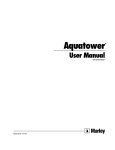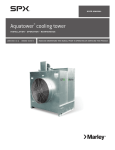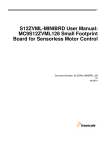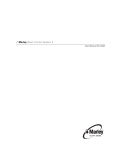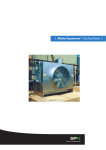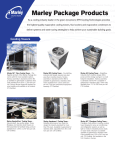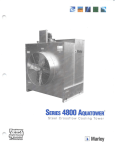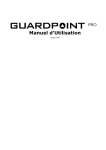Download Marley Aquatower Cooling Tower Installation, Operation and
Transcript
U S E R M A N UA L Aquatower® cooling tower I N S TA L L AT I O N - O P E R AT I O N - M A I N T E N A N C E M01-1248F I SSU E D 8/2012 R EAD AN D U N D E R STAN D TH I S MAN UAL PR IOR TO OPE RATI NG OR S E RVICI NG TH I S PROD UCT. contents This Manual contains vital information for the proper installation and operation of your cooling tower. Carefully read the manual before installation or operation of the tower and follow all instructions. Save this manual for future reference. Tower Installation.........................................................................................................3 Piping to Tower.............................................................................................................4 Mechanical Equipment Installation..........................................................................5 Motor Electrical Connections...................................................................................8 Starting and Operating Instructions........................................................................9 Fan Cycling Limits....................................................................................................11 Wintertime Operation..............................................................................................12 Maintenance Instructions........................................................................................14 Blowdown...................................................................................................................16 Seasonal Shutdown Instructions..........................................................................17 Troubleshooting.........................................................................................................18 Wiring Diagrams.......................................................................................................19 Parts List.....................................................................................................................22 The following defined terms are used throughout this manual to bring attention to the presence of hazards of various risk levels, or to important information concerning the life of the product. Warning Indicates presence of a hazard which can cause severe personal injury, death or substantial property damage if ignored. Caution Indicates presence of a hazard which will or can cause personal injury or property damage if ignored. Note 2 Indicates special instructions on installation, operation or maintenance which are important but not related to personal injury hazards. installation Receiving Inspection The motor and miscellaneous parts ship with the tower. Check motor nameplate to be sure that power supply and motor have the same characteristics. Inspect the entire shipment for any damage that may have occurred in transit. Tower Location Warning The cooling tower must be located at such distance and direction to avoid the possibility of contaminated tower discharge air being drawn into building fresh air intake ducts. The purchaser should obtain the services of a Licensed Professional Engineer or Registered Architect to certify that the location of the tower is in compliance with applicable air pollution, fire, and clean air codes. Locate so prevailing wind will blow into the louvered face, and direct fan discharge away from building surfaces. Locate so there is free air flow to and from the tower. Allow clearance on all sides for maintenance. Indoor Installation Use a duct from the tower air discharge to the outside. You may also want to install an inlet air duct. Do not allow the total pressure loss through ducts to exceed 0.10 inches H2O. To minimize pressure losses: • Use 20% oversize ducts. • Avoid sharp turns or abrupt changes in size. • Keep duct length to a minimum. • Screened or louvered openings should have a net free area at least 20% greater than the tower discharge opening area. Attach ducts to the tower using flexible connections, and support ducts independently from the tower. Provide access openings for servicing the mechanical equipment if air discharge ducts are installed. If the duct discharges into the prevailing wind, you may need to install a windbreak or an elbow to serve as a deflector. Ducts installed on towers with year-round usage should be water tight and insulated to prevent condensation. ➠ 3 installation Tower Installation Install tower in a level position on a stable foundation. Anchor tower to the foundation through holes at base of tower, using four 3⁄8” diameter bolts (not supplied). Remove strapping and brackets from the louver face on models 494—496 and reinstall the bolts to the cold water basin. Install the overflow (fiberglass models only) as shown in Figure 1. INSTALL DRAIN FITTING WITH GASKET ON TOP Figure 1 Piping to Tower (Summer–Only Operation) 1. Use large enough piping to minimize friction loss. 2. Connect float valve to makeup water supply. Install the threaded valve stem and float located in the loose parts package. 3. Install a valved blowdown line at some point in the system, preferably in the hot water line near the top of the tower, so that water will flow through the line whenever the pump is operating. (Blowdown is the continuous removal of a small amount of water during operation to retard scale and corrosion.) Inlet Cooling Tower with Bottom Outlet Gravity Line from Outlet Indoor Storage Tank Figure 2 4 Overflow and Drain to Sewer Make-Up Line Pump Heat Load installation Piping to Tower (Year–Round Operation) 1. If your tower must operate during freezing weather, it is recommended that the tower be installed for gravity flow operation. See Figure 2. 2. Provide an indoor open type storage tank with a capacity that will contain all water that will drain into the tank from the system during shutdown. 3. Connect tower outlet to storage tank. Bottom outlet option should be used for gravity flow. 4. Install makeup water, bleed-off, overflow and drain lines on tank. 5. Insulate and heat water lines exposed to freezing temperatures. Mechanical Equipment Installation Aquatowers with factory-installed controls ship with the motor, sheave, belt, and belt guard factory-installed. Remove shipping stiffener plate and hardware at the adjustable end of the motor support plate and proceed to Motor Electrical Connections. Note Motor, Sheave, and V-Belt Installation 1. Check the motor nameplate to be sure its voltage, phase and frequency ratings are the same as the power supply. ➠ Belt Guard for Steel Aquatower Shown Motor Frame Fastener Size 56–143T–145T 5 ⁄16" 182T thru 215T 3 1/4" TAP SCREW ⁄8" Figure 3 SUPPORT BRACKET (WITH ADJUSTMENT SLOTS) 5 installation 2. Make sure the fan is tightly secured to the bearing housing shaft and that it rotates freely. Make sure the bearing housing is secured to its support. 3. Attach motor to motor base with four bolts, flat washers, lock washers and nuts provided, see Figure 3. You may want to loosen the adjusting bolts and raise the motor base so you can reach under the motor base to tighten the motor hold-down bolts. MOTOR SHEAVE PLUMB LINE SHEAVES MUST BE PARALLEL TO EACH OTHER AND IN THE SAME PLANE OF OPERATION FAN SHEAVE Figure 4 4. Apply a rust preventive coating to the motor shaft to prevent shaft corrosion and to ease sheave installation and removal. 5. Install motor sheave and align it with fan sheave. Motor support brackets are slotted to assist in alignment. See Figure 3. A plumb line will be helpful in aligning sheaves. See Figure 4. 6. Remove the fan guard and fan cylinder splice plate (steel tower only) at the top of the fan cylinder. Install the belt over the fan by passing the belt over the fan and rotating the fan blades past the belt. Install the belt onto the sheaves. 6 installation 7. Use the adjusting bolts on the motor support to adjust belt tension. A correctly tensioned belt does not slip when the fan is running—and the “tight” side is straight between sheaves. The “slack” side will have a slight bow. If possible, use a commercially available tension measuring device. Avoid over-tensioning. Too much tension reduces bearing and belt life. Check the tension on new belts after 8 to 12 hours of operation. 8. Install the belt guard as shown in Figure 3 for a steel tower or Figure 5 for a fiberglass tower. 9. Install fan cylinder splice plate (steel tower) and fan guard. 10. Check bearing housing oil cup level. Fill to the proper level with SAE 30 (ISO 100) weight oil. Belt Guard for Fiberglass Aquatower Shown 3/8" x 1 1/2" BOLT 3/8" WASHERS USE 3/8" WASHERS TO SHIM AS REQUIRED 3/8" NEOPRENE WELL-NUT Figure 5 7 installation Motor Electrical Connections If Aquatower is equipped with Marley Control System, refer to Control System Manual for wiring instructions. Note Connect motor to power supply in accordance with the National Electric Code and local requirements. Failure to wire the motor correctly will void its warranty. Overload protection for motors must be part of the control system. Figure 6 shows one possible control scheme. Other various wiring diagrams appear on pages 19 through 22. 2-WIRE CONTROL (IF USED) STOP L1 M L2 L3 START M M OL M M NOTE: L3 IS USED ON 3-PHASE MOTOR ONLY. Figure 6 8 MOTOR operation Starting and Operating Instructions Warning Among other sources, outbreaks of Legionnaires’ Disease have reportedly been traced to cooling towers. Maintenance and water treatment procedures that prevent amplification and dissemination of Legionella and other airborne bacteria should be formulated and implemented BEFORE systems are operated and continued regularly thereafter to avoid the risk of sickness or death. 1.New installations should be cleaned and treated with biocides by a water treatment expert before startup. 2. Clean all debris, such as leaves and dirt from the cooling tower fill and basin. 3. Fill the circulating system with water. The cold water basin should be filled with water until level is at the rim of the overflow. The water conditions during the initial tower operation are crucial in preventing premature corrosion of galvanized steel (white rust). For at least the first eight weeks of operation, pH should be controlled between 6.5 and 8.0 with hardness and alkalinity levels between 100 and 300 ppm (expressed as CaCO3). Note If tower is equipped with a standard side-suction connection, vent any accumulated air from the top of the suction hood by removing one or both tap screws provided at that location. Replace these tap screws when venting is complete. 4. Start your pump(s). Observe system operation. Since the water system external to the tower will have been filled only to the level in the cold water basin, some “pump-down” of the basin water level will occur before water completes the circuit and begins to fall from the fill. The initial pump-down may not be enough to cause the float valve to open. However, you can check its operation by pressing down on the operating lever. Adjust the float valve during tower operation with heat load to maintain 4" water depth in the depressed section of the basin on Models 490—493. Maintain 51⁄2" water depth on Models 494—496. ➠ 9 operation Note Hot water temperatures exceeding 125°F could damage PVC fill. 5. Make sure blowdown line is discharging water. 6. Depth of water in hot water basin should be uniform. If the basin overflows, reduce the flow rate. Do not pump more water than design capacity. 7. Continue pump operation for about 15 minutes, after which it is recommended that the water system be drained, flushed, and refilled. 8. While operating the condensing water pump(s) and prior to operating the cooling tower fan, execute one of the two alternative biocidal treatment programs described in the following: • Resume treatment with the biocide which had been used prior to shutdown. Utilize the services of the water treatment supplier. Maintain the maximum recommended biocide residual (for the specific biocide) for a sufficient period of time (residual and time will vary with the biocide) to bring the system under good biological control or • Treat the system with sodium hypochlorite to a level of 4 to 5 mg/L (ppm) free chlorine residual at a pH of 7.0 to 7.6. The chlorine residual must be held at 4 to 5 mg/L (ppm) for six hours, measurable with standard commercial water test kits. 10 If the cooling tower has been in operation and then shut down for a duration of time and not drained, perform one of the two previous biocidal treatment programs directly to the cooling water storage vessel (cooling tower sump, drain down tank, etc.) without circulating stagnant water over the cooling tower fill or operating the cooling tower fan. After biocidal pretreatment has been successfully completed, cooling water may be circulated over the tower fill with the fan off. When biocidal treatment has been maintained at a satisfactory level for at least six hours, the fan may be turned on and the system returned to service. Resume the standard water treatment program, including biocidal treatment. operation 9. Check fan for free rotation and check oil level in bearing housing as required (see maintenance instructions). Start motor and check direction of rotation. Fan must rotate clockwise when viewed from the fan discharge side. If the rotation is incorrect, change any two of the three motor leads. Fan cycling limits Note Considering the normal fan and motor sizes utilized on Aquatowers, anticipate that approximately 4 to 5 starts per hour are allowable. If your tower is equipped with a two-speed motor, you will enjoy greater opportunity for temperature control. When the water temperature becomes too cold, switching the fan to half-speed will cause the cold water temperature to rise—stabilizing at a temperature a few degrees higher than before. With a further reduction in water temperature, the fan may be cycled alternately from half-speed to off. Note Do not start the motor more than four to five times per hour (each low speed start and each high speed start count as one start). For greater insight on cold water temperature control, please read “Cooling Tower Energy and its Management”, Technical Report #H-001-A, available on our website. 11 operation Wintertime Operation: The Marley fill system used in the Aquatower has air entrance louvers that are molded as an integral part of the fill. This feature makes these towers very forgiving of cold weather operation, even at the low temperature and reduced load conditions encountered in free cooling and other low temperature applications. Nevertheless, during operation in subfreezing weather the opportunity exists for ice to form in the colder regions of the tower. Note Slushy, transitory ice forms routinely in the colder regions of the fill of low temperature towers, and is visible through the tower louvers. Such ice normally has no adverse effect on tower operation, but its appearance should be a signal to the operator to undertake ice control procedures. It is the operator's responsibility to prevent the formation of destructive (hard) ice on the cooling tower fill. Certain guidelines should be followed: 1. Do not allow the tower’s leaving water temperature to drop below a minimum allowable level—say 36°F to 40°F. If such low temperature operation is necessary or beneficial to your process, establish the minimum allowable level as follows: During the coldest days of the first winter of operation, observe whether any ice is forming on the louver face, particularly near the bottom part of the louver face. If hard ice is present on the louvers, you must increase the allowable cold water temperature. If the coldest possible water is beneficial to your process, ice of a mushy consistency can be tolerated—but routine periodic observation is advisable. Caution If the minimum allowable cold water temperature is established at or near minimum heat load, it should be safe for all operating conditions. 2. As cold air enters the louvers, it causes the water flowing over the fill to be drawn inward toward the center of the tower. Thus, under fan operation, the louvers and lower periphery of the tower structure remain partly dry, seeing only random splashing from within the tower—plus normal atmospheric moisture from the entering air. Such lightly wetted areas are most subject to freezing. 12 operation Therefore, if excessive ice forms on the louvers, stop the fan for a few minutes. With the fan off, the water flow will increase in the vicinity of the louvers and reduce the ice buildup. 3. Under extended extreme cold conditions, it may be necessary to operate the fan in reverse. This forces warm air out through the louvers, melting any accumulated ice—adequate heat load must be available. Reversal of fan should only be done at half speed or less. Reverse operation of the fan should be used sparingly and should only be used to control ice, not to prevent it. Reverse fan operation should not need to exceed 1 or 2 minutes. Monitoring is required to determine the time required to melt accumulated ice. Warning Operating the fan in reverse at half speed for prolonged periods during subfreezing weather can cause severe damage to fans and fan cylinders. Ice can accumulate inside fan cylinders at fan blade plane of rotation and fan blade tips will eventually strike this ring of ice, damaging the fan blades or cylinder. Ice can also accumulate on fan blades and be thrown off, damaging fan cylinder or blades. Allow a minimum of 10 minute delay between reverse operation and forward operation during subfreezing weather to permit ice to dissipate from fan blades and fan cylinders. See Fan cycling limits on page 11 of this manual. 4. With no heat load on the circulating water, icing cannot be controlled effectively by air control during freezing weather. Towers must not be operated with reduced water rate and/or no heat load during freezing weather. If the circulating water system cannot be shut down, water returning from the process should be made to bypass the tower. If a bypass is used, all water must be bypassed without modulation. 13 maintenance Maintenance Instructions Warning Always make certain that mechanical equipment is inoperable during periods of maintenance—or during any situation of possible endangerment to personnel. If your electrical system contains a disconnect switch, lock it out until the period of exposure to injury is over. The top of the tower is not a working surface. Do not stand, sit or walk on top of the tower. Use an appropriate ladder adjacent to the tower whenever you perform any maintenance activity on the tower’s upper surfaces. This product is constructed of fiberglass or cold-formed sheet metal. Use protective clothing, gloves and shoes as appropriate for protection against edges of thin gage material. Motor Lubricate the motor according to the motor manufacturer’s supplied instructions. Remove any oil, dust or scale deposits from the motor which can cause excessive insulation temperatures. Refer to Electric Motors on Cooling Towers, Manual 92-1475, for additional maintenance and lubrication information. Fan Shaft Bearing Housing Check bearing housing oil cup level. Fill to the proper level with SAE 30 (ISO 100) weight oil. Belt Tension Check belt tension every two to three weeks during peak operating season. Makeup Float Valve Check float valve periodically for proper operation and proper water level. Basin and Suction Screen Drain and clean cold water basin and suction screen periodically. Blowdown Check the blowdown for continuous water discharge during operation. 14 maintenance Cooling Tower Cleaning Warning Any evaporative-type cooling tower must be thoroughly cleaned on a regular basis to minimize the growth of bacteria, including Legionella Pneumophila, to avoid the risk of sickness or death. Service personnel must wear proper personal protective equipment during decontamination. Do NOT attempt any service unless the fan motor is locked out. Operators of evaporative cooling equipment, such as water cooling towers, should follow maintenance programs which will reduce to an absolute minimum the opportunity for bacteriological contamination. Public Health Service officials have recommended that “good housekeeping” procedures be followed, such as: regular inspections for concentrations of dirt, scale, and algae; periodic flushing and cleaning; and the following of a complete water treatment program including biocidal treatment. See Starting and Operating Instructions on page 9. A visual inspection should take place at least once a week during the operating season. Inspect for bacterial growth and general operation conditions. Bacterial growth should be reported to your water treatment expert for immediate attention. At a minimum, cooling towers should be cleaned and disinfected with biocides twice a year. Systems with biofouling or positive cultures of legionella may require additional cleaning. Inspect louvers, drift eliminators and basin trash screens and remove any debris or scale which may have accumulated. Replace any damaged or worn out components. The louvers, drift eliminators and easily accessible fill surfaces should be flushed by use of a moderate-pressure water nozzle, being careful not to cause physical damage. Use of high-pressure water may damage the eliminator and louver material. A reliable water treatment program should be installed and maintained. Filtration devices may be employed to reduce the suspended solids concentrations, thus increasing the effectiveness of the water treatment program. 15 maintenance Blowdown A cooling tower cools water by continuously causing a portion of it to evaporate. Although the water lost by evaporation is replenished by the makeup system, it exits the tower as pure water – leaving behind its burden of dissolved solids to concentrate in the remaining water. Given no means of control, this increasing concentration of contaminants can reach a very high level. In order to achieve water quality which is acceptable to the cooling tower (as well as the remainder of your circulating water system), the selected water treatment company must work from a relatively constant level of concentrations. This stabilization of contaminant concentrations is usually accomplished by blowdown, which is the constant discharge of a portion of the circulating water to waste. As a rule, acceptable levels on which to base a treatment schedule are in the range of 2–4 concentrations. The following table gives approximate blowdown rates (percent of total water flow rate constantly wasted) to achieve those concentrations at various cooling ranges*: Blowdown Rate CoolingTwo Four Range (°F) Concentrations Concentrations 6 0.7%0.17% 8 1.1%0.30% 11 1.5%0.43% *Range is the difference between hot water temperature entering the tower and cold water temperature leaving the tower. Note When water treatment chemicals are added, they should not be introduced into the circulating water system via the cold water basin of the cooling tower. Water velocities are lowest at that point, which results in inadequate mixing and may damage the cooling tower. Intermittent Wintertime Operation: If periods of shutdown (nights, weekends, etc.) occur during freezing weather, measures must be taken to prevent the water in the cold water basin—and all exposed pipework—from freezing. Several methods are used to combat this, including automatic basin heater systems available from Marley. Caution Warning 16 Unless some means of freeze prevention is incorporated into your system, the tower basin and exposed pipework should be drained at the beginning of each wintertime shutdown period. If tower basin is drained, verify that all basin heaters have been shut off either by automatic cutoff or disconnect switch. maintenance Seasonal Shutdown Instructions When the system is to be shut down for an extended period of time, it is recommended that the entire system (cooling tower, system piping, heat exchangers, etc.) be drained. Leave the basin drain open. During shutdown, clean the tower and make any necessary repairs. Apply protective coating as required to all metal parts. Pay particular attention to bearing housing supports. Bearing Housing • At shutdown, check the oil level in the oil cup. • At start of new operating season, operate until the oil is warm—drain and refill. Use SAE 30 (ISO 100) weight oil. • Bearing housing must be refilled at the point where the oil line from the oil reservoir cup connects to the bearing housing. Attach oil line and fill line and oil cup. Fan guard will have to be removed to change oil. Each month check the oil level at the oil cup. Electric Motor Clean and lubricate motor at close of each operating season. Refer to motor manufacturer’s recommendations. Warning Do not start motor before determining that there will be no interference with free rotation of the fan drive. The motor should be run for three hours at least once a month to dry out windings and relubricate bearing surfaces. Refer to Electric Motors on Cooling Towers, Manual 92-1475. At start of new operating season, make sure bearings are adequately lubricated before returning motor to service. Prolonged Shutdown If shutdown period is longer than seasonal, contact your Marley Sales Representative for additional information. Note Whenever you order parts, or correspond with us about your tower, please include the tower serial number, located on the tower's name plate. 17 troubleshooting Trouble Unusual motor noise Motor runs hot Unusual fan drive vibration 18 Cause Remedy Motor running single-phase Stop motor and attempt to start it. Motor will not start if singlephased. Check wiring, controls and motor. Motor leads connected incorrectly Bad bearings Electrical unbalance Rotor unbalance Motor overload, wrong voltage or unbalanced voltage Check motor connections against wiring diagram on motor. Check lubrication. Replace bad bearings. Check voltage and currents of all three lines. Correct if required. Rebalance. Check voltage and current of all three lines against nameplate values. Check nameplate RPM of motor and sheave ratio against parts list. Wrong fan RPM Check nameplate RPM of motor and sheave ratio against parts list. Measure RPM. Bearings overgreased Remove grease reliefs. Run motor up to speed to purge excessive grease. Wrong lubricant in bearings One phase open Change to proper lubricant. See motor manufacturer’s instructions. Stop motor and attempt to start it. Motor will not start if singlephased. Check wiring, controls and motor. Poor ventilation Clean motor and check ventilation openings. Allow ample ventilation around motor. Winding fault Bent motor shaft Insufficient grease Too frequent starting Deterioration of or foreign material in grease Check with Ohmmeter. Straighten or replace shaft. Remove plugs and regrease bearings. Limit cumulative starting time to a total of 30 seconds each hour. Flush bearings and relubricate. Bearings damaged Loose bolts and cap screws Replace bearings. Tighten all bolts and cap screws on all mechanical equipment and supports. Worn fan shaft bearings Bent shaft Misalignment Loose or stretched belt Unbalanced motor Replace bearings. Replace shaft. Make sure fan and motor are straight and properly aligned. Check belt for proper tension. Disconnect load. Remove sheave, tape key in keyway and operate motor. If motor still vibrates, rebalance motor. wiring diagrams Capacitor Start Single Phase Motors, Reversible, Double Voltage T1-L1 T1-L1 T2 T2 T3 T3 T4 T4 T8 T8 T5-L2 T5-L2 Without Thermal Overload (Integral HP) High Voltage 1. Connect T1 and L1 and insulate. 2. Connect T2, T3 and T8 and insulate. 3. Connect T4, T5 and L2 and insulate. Low Voltage 1. Connect T2, T3, T8 and L1 and insulate. 2. Connect T2, T4, T5 and L2 and insulate. P1-L1 P1-L1 T2 T2 T2 T2 T3 T3 T4 T4 T8 T8 T5-L2 T5-L2 With Thermal Overload (Fractional HP) High Voltage 1. 2. 3. 4. Insulate P2. Connect T2, T3 and L8 and insulate. Connect T4, T5 and L2 and insulate. Connect P1 and L1 and insulate. ➠ 19 wiring diagrams Low Voltage 1. Connect P1 and L1 and insulate. 2. Connect P2, T3, and T8 and insulate. 3. Connect T2, T4, T5 and L2 and insulate. General Colors may be substituted for numbers as follows: T1—Blue T5—Black T2—White T6—Red T3—Orange P1—No Color Assigned T4—Yellow P2—Brown To reverse rotation, interchange leads T5 and T8. Three Phase Motors There are two basic ways of wiring a three phase motor, Wye and Delta. The following show the terminal connections that could be used in Marley motors. Numbers could be stamped on insulation or cloth, plastic or metal bands around each lead. 1. Three Wire Single Voltage Motors—Leads are not always numbered. They could be numbered 1,2,3 or T1, T2 and T3. T1 T1 T1 T1 WYE WYE T3 T3 T2 T2 DELTA DELTA T3 T3 T2 T2 2.Nine Wire Dual Voltage Motors—Leads are numbered 1, 2, 3, 4, 5, 6, 7, 8 and 9 or T1, T2, T3, T4, T5, T6, T7, T8 and T9. 20 wiring diagrams NAMEPLATE T1 T4 T5 T6 T7 T8 T9 T4 T5 T6 T7 T1 T8 T2 T9 T3 T4 T7 T9 T6 T8 T3 WYE T1 T5 L1 T2 T2 T3 L2 L3 LOW V L1 L2 L3 HIGH V Voltage L1 L2 L3 Tie Together Low T1 T7 T2 T8 T3 T9 T4 T5 T6 High T1 T2 T3 (T4 T7) (T5 T8) (T6 T9) NAMEPLATE T1 T4 T9 T6 T3 Voltage Low T7 L1 T2 L1 T4 T5 T6 T7 T1 T8 T2 T9 T3 T6 T4 DELTA T7 T8 T5 T5 L2 T8 T9 T1 T2 L2 L3 LOW V T3 L3 L1 Tie Together (T1 T7 T6) (T2 T8 T4) (T3 T5 T9) High T1 T2 L2 L3 HIGH V T3 (T4 T7) (T5 T8) (T6 T9) 3. Two Speed Single Winding (Consequent Pole) Variable Torque Motor— Leads are marked 1, 2, 3, 4, 5 and 6 or T1, T2, T3, T4, T5 or T6. T4 T1 T3 T5 NAMEPLATE T2 T4 T5 T6 T1 T2 T3 T1 T2 T3 T6 T4 T5 L1 L2 L3 LOW SPEED T6 Speed L1 L2 L3 Low T1 T2 T3 High T6 T4 T5 Tie Together L1 L2 L3 HIGH SPEED Insulate Separately T4-T5-T6 T1 T2 T3 21 parts list 490 Aquatower — 60 Cycle Motor Application Contact your local Marley sales representative for prices and availability, to place your order, or for help with identifying parts. To find you local Marley sales representative call 913 664 7400 or visit us online at spxcooling.com. Model Number V-Belt A75 490A 490D 693531 693531 A112 492D 492G 221820 221820 A103 493G 564534 A105 Fan 493H 320333 Motor Sheave* D24662 176552 173534 187880 058891 157503 F an Sheave D24665 D24665 224717 224717 D24665 D24665 24" Dia. D02974 D02974 D02975 D02975 D02976 D02976 C72316 C72316 C53625 C53625 36" Dia. 42" Dia. C72316 C53623 C53623 C72316 C72316 C53624 C53624 Fan Guard C72316 Float Valve 1301SE Bearing Housing 24" Dia. HDG Brass Body 3/4" NPT 155929 155929 155929 155929 155929 155929 Brass Stem 720755 720755 720755 720755 720755 720755 Plastic F loat 720680 720680 720680 720680 720680 720680 494G 494H 494K 495K 495M 496K 496M 216234 216234 216234 D24674 D24674 36" Dia. HDG 42" Dia. HDG Model Number V-Belt 2A128 B133 D24630 B136 D19540 Fan 2BX 136 Motor Sheave* 254425 D24663 D24664 D19541 187880 254425 265314 F an Sheave D24666 D24666 D24666 B84734 B84734 D24666 D24666 48" Dia. D02977 D02977 D02977 D02978 D02978 D02979 D02979 574194 574194 54" Dia. 66" Dia. 574194 574194 C53626 C53626 C53626 574194 574194 C53627 C53627 Fan Guard 574194 48" Dia. HDG C53628 C53628 Float Valve 118SE Bearing Housing Brass Body 3/4" NPT 155929 155929 155929 155929 155929 155929 155929 Brass Stem 088708 088708 088708 088708 088708 088708 088708 Plastic F loat 720680 720680 720680 720680 720680 720680 720680 54" Dia.HDG 66" Dia.HDG * Motor sheave part number shown is for a standard motor frame application. Because of the various motor frame options the Aquatower serial number is required to insure correct sheave replacement part. 22 parts list 490 Aquatower — 50 Cycle Motor Application Model Number V-Belt A75 490A 490D 492D 492G D24672 A112 221820 A120 197632 Fan 320333 320333 Motor Sheave* 161505 D24671 D24670 197756 D24669 173492 F an Sheave D24665 D24665 224717 224717 D24665 D24665 24" Dia. D02974 D02974 D02975 D02975 D02976 D02976 C72316 C72316 36" Dia. Float Valve Fan Guard 42" Dia. 1301SE Bearing Housing C72316 C72316 24" Dia. HDG C53623 C53623 36" Dia. HDG C72316 C72316 C53624 C53624 42" Dia. HDG C53625 C53625 Brass Body 3/4" NPT 155929 155929 155929 155929 155929 155929 Brass Stem 720755 720755 720755 720755 720755 720755 Plastic F loat 720680 720680 720680 720680 720680 720680 494G 494H 494K 495K 495M 496K 496M 216234 216234 D19540 D19540 Model Number 2A128 2A136 D24673 B136 Fan 2B140 B32344 B32344 Motor Sheave* 266205 D24664 D19594 196246 D19542 266205 273771 F an Sheave D24666 D24666 D24666 B84734 B84734 D24666 D24666 48" Dia. D02977 D02977 D02977 D02978 D02978 D02979 D02979 574194 574194 54" Dia. 66" Dia. Float Valve Fan Guard 493H 693531 A77 A105 V-Belt 493G 118SE Bearing Housing 574194 574194 574194 48" Dia. HDG C53626 C53626 C53626 54" Dia.HDG 574194 574194 C53627 C53627 C53628 C53628 Brass Body 3/4" NPT 66" Dia.HDG 155929 155929 155929 155929 155929 155929 155929 Brass Stem 088708 088708 088708 088708 088708 088708 088708 Plastic F loat 720680 720680 720680 720680 720680 720680 720680 * Motor sheave part number shown is for a standard motor frame application. Because of the various motor frame options the Aquatower serial number is required to insure correct sheave replacement part. 23 parts list 490 Aquatower — 60 and 50 Cycle Motor Use this table to identify the Aquatower motor. Contact your local Marley sales representative for prices and availability, to place your order, or for help with identifying the correct motor. Model Number 490A 490D 492D 492G 493G 2 hp 3/60/200/1800 rpm 145T Frame C04719 C04719 2 hp 3/60/230/460/1800 rpm145T Frame* C04720 C04720 2 hp 3/60/575/1800 rpm 145T Frame C04721 C04721 493H Motor 60 Cycle ¹⁄₃ hp 1/60/115/230/1800 rpm 56 Frame* 454215 1 hp 3/60/200/1800 rpm 143T Frame C04703 C04703 1 hp 3/60/230/460/1800 rpm 143T Frame* C04704 C04704 1 hp 3/60/575/1800 rpm 143T Frame C04705 C04705 3 hp 3/60/200/1800 rpm 182T Frame C04736 3 hp 3/60/230/460/1800 rpm 182T Frame* C04737 3 hp 3/60/575/1800 rpm 182T Frame C04738 Model Number 494G 494H 494K 495K 495M 496K 5 hp 3/60/200/1800 rpm 184T Frame C11602 C11602 C11602 5 hp 3/60/230/460/1800 rpm 184T Frame* C11604 C11604 C11604 5 hp 3/60/575/1800 rpm 184T Frame C11606 C11606 496M Motor 60 Cycle 2 hp 3/60/200/1800 rpm 145T Frame C04719 2 hp 3/60/230/460/1800 rpm145T Frame* C04720 2 hp 3/60/575/1800 rpm 145T Frame C04721 3 hp 3/60/200/1800 rpm 182T Frame C04736 3 hp 3/60/230/460/1800 rpm 182T Frame* C04737 3 hp 3/60/575/1800 rpm 182T Frame C04738 C11606 7¹⁄₂ hp 3/60/200/1800 rpm 213T Frame C11618 C11618 7¹⁄₂ hp 3/60/230/460/1800 rpm 213T Frame* C11620 C11620 7¹⁄₂ hp 3/60/575/1800 rpm 213T Frame C11622 C11622 7¹⁄₂ hp 3/60/208/1800/900 rpm 215T Frame 235085 235085 7¹⁄₂ hp 3/60/460/1800/900 rpm 215T Frame 652636 652636 7¹⁄₂ hp 3/60/575/1800/900 rpm 215T Frame 235168 235168 * Indicates standard motor for each model. Other motors shown are available for particular electrical supply characteristics. Check the motor nameplate information before you order. 24 parts list 490 Aquatower — 60 Cycle Motor Application Use this table to identify the Aquatower motor. Contact your local Marley sales representative for prices and availability, to place your order, or for help with identifying the correct motor. Model Number 490A 490D 492D 221176 221176 492G 493G 223974 223974 493H Motor 50 Cycle ¹⁄₃ hp 1/50/115/230/1500 rpm 56 Frame 205492 1 hp 3/50/220/380/1500 rpm 143T Frame 2 hp 3/50/220/380/1500 rpm 182T Frame 3 hp 3/50/220/380/1500 rpm 182T Frame Model Number 230722 494G 494H 494K 495K 233056 233056 495M 496K 496M 235275 233056 235275 Motor 50 Cycle 2 hp 3/50/220/380/1500 rpm 182T Fram 3 hp 3/50/220/380/1500 rpm 182T Frame 5 hp 3/50/220/380/1500 rpm 213T Frame 7¹⁄₂ hp 3/50/220/380/1500 rpm 215T Frame 223974 230722 25 Aquatower user manual S PX C O O L I N G T E C H N O LO G I E S , I N C . 7401 W 129 STREET OVERLAND PARK, KANSAS 66213 USA P: 913 664 7400 F: 913 664 7439 [email protected] In the interest of technological progress, all products are subject to design and/or material change without notice ISSUED 08/2012 M01-1248F COPYRIGHT ©2012 SPX Corporation




























